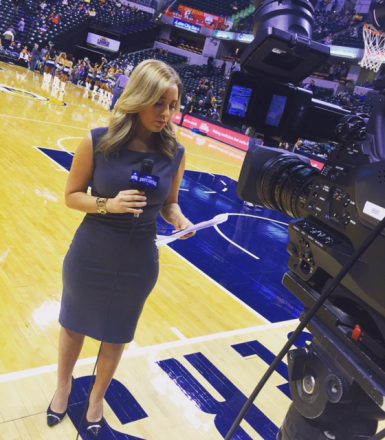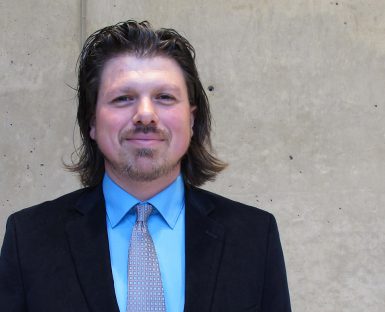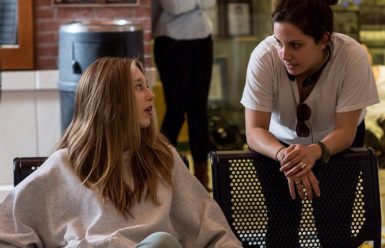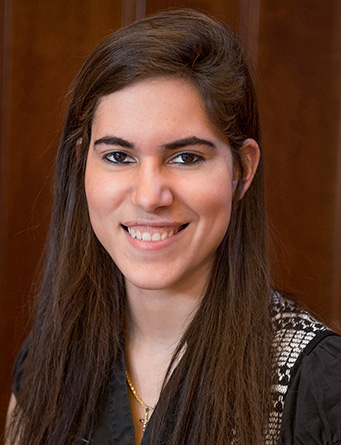Female media pros often face gender backlash, online harassment

A few months after Tricia Whitaker started her first job as a sports reporter and anchor for WBAY-TV in Green Bay, Wisconsin, her boss issued a warning.
Whitaker, BAJ’12, said he pulled her into his office and told her, “People are tweeting saying you can’t do this job because you’re a female and a dumb blonde. Don’t let them be right.”
This kind of attitude toward women in media is far from rare, and Media School faculty say they are addressing diversity and gender issues in the classroom to create awareness and prepare students for the less desirable realities of the workplace.
One of those realities is online harassment on social media. The recent Women’s Media Center’s 2015 Status of Women in the U.S. Media report found Whitaker’s experience is not unique. In the report, which covers all forms of media, a survey found that 25 percent of women 18-24 have been sexually harassed online.
“I think that girls need to know before they go into the industry that it’s a prerequisite to have really thick skin,” Whitaker said. “As much as we want to say ‘It won’t bother me, no matter how many times I get called fat,’ eventually it starts creeping into your mind, and you have to fight against it.”
Whitaker, who is now the sports anchor at CBS4 WTTV in Indianapolis, was shocked by the comments she began receiving from viewers when she started her first job. Any time she slipped up on the air, she was branded as a woman who knew nothing about sports, while viewers gave her male counterparts the benefit of the doubt.
And, as most women who report harassment have found, the attacks often have nothing to do with their job performance. Whitaker said she often received emails, phone calls and social media messages critiquing her appearance.
“I would always get comments on my looks, whether they were a good critique or a bad critique. Some people would tell me I’m too fat for my dress, some people would say ‘nice rack,’ but all comments were horribly inappropriate,” she said.
Another alumna in sports journalism, Julie DiCaro, BAJ’95, and sports reporter Sarah Spain founded a hashtag movement, #MoreThanMean, to raise awareness about this harassment. They appear in a video addressing issues of online harassment of female reporters. In the video, men (who were not the posters of the comments but volunteered to assist in the project) sat across from female sports journalists and read the most aggressive comments. The male volunteers are clearly uncomfortable reading the tweets, which ranged from “someone should beat you with a hockey stick like the whore you are” to far worse.

Harassment is not limited to female sports journalists. New York Times writer Amanda Hess, who visited the school last spring, shared similar tales of years of online harassment that centered on her appearance and not her work. Her story that details her experience, “Why Women Aren’t Welcome on the Internet,” won the National Magazine Award for public interest in 2015.
“Women have gained so much visibility and so many spaces to speak their minds — in my case to have this journalism career — but one way that some people can still bring women down is by assaulting them or reducing them to their bodies,” Hess said during her visit in February. “That’s what’s happening online, a way for men to exert power over women.”
While the online harassment comes mostly from viewers or readers, not male co-workers, faculty at the school say classroom environment is a place to start changing the climate. Associate professor and National Sports Journalism Center director Galen Clavio said gender integration through other extracurricular opportunities like IUSTV and Big Ten Network Student U is the key to solving sexism in the professional field. He said if young men can learn early on to work with and respect female colleagues, they will take that respect with them when they leave the university and enter the workforce.
Clavio also cited mentorship and resources for women at IU as important tools for fostering gender equity. One of his first duties after assuming the role of director last year was to launch an IU chapter of the Association for Women in Sports Media, which now has 20 members.
The formation of The Media School has made these integrations more possible, according to Clavio.
“Before The Media School existed, all of these opportunities for men and women to get involved with sports communication were kind of hard to find,” he said. “Now that things are more centralized, we can provide a platform for sports communicators of different genders to come together and do great work.”
Gender stereotypes fuel the problem
In other areas of media, representations of women in the work itself affect the way men and women interact in the workplace. Doctoral student Teresa Lynch’s research looks at gender representations in games and sexualized workplace environments that face female game designers.
Last summer, #Gamergate exploded online, first as a campaign for the “free speech” right to aim criticism toward female game developer and female journalists writing about the game industry. Soon, it became a platform for heated discussion about online abuse. Lynch commented at the time that she hopes to contribute to the fight against mistreatment of women in virtual spaces through her research, to explore not just the effects these kinds of defamatory attacks have on people, but why they happen in the first place.

Game design professor Ted Castronova said he is well aware of the “boys club” reputation the gaming community has built and is actively trying to debunk it at IU. He and other game design faculty have been hosting focus groups with prospective female students, tailoring teaching styles and creating strategies to create an inclusive environment at The Media School.
For example, Castronova found that female students are more likely to take an introductory game design class that welcomes all students regardless of knowledge level as opposed to an intense, “weed out” course. He also has been developing strategies for increasing numbers of female faculty members, including creating an endowed position or enlisting female graduate students to teach courses.
Campus resources outside The Media School also help create a welcoming environment for women gamers. The Center of Excellence for Women in Technology and the Women in Game Design organization offer networking opportunities, professional development resources and an opportunity to meet fellow female students with similar interests.
Lynch said measures like this are imperative for the future of the industry, because the boys-only status of the video game community is a cyclical issue. Women do not want to play video games because of over-sexualized female avatars, which decreases the number of females who want to develop games and help correct gender representations.
Flat, female representations of women exist in television and film as well, according to filmmaker Hannah Fidell, BS’07. Fidell’s films, The Teacher and Six Years, have been favorites at the Sundance Film Festival.
“It’s rare that a show can get the female character right,” she said. “The way you solve women’s problems and create the depth of a woman is to have female writers and directors. This is what is really lacking in the industry.”
Women in media leadership roles could effect change
Like Fidell, lecturer Susanne Schwibs said that misrepresentation and harassment in media may be due to lack of women in leadership roles. Schwibs, who teaches classes in film theory and production, said men often are bothered by female producers who take charge on set. This can lead to females’ ideas and suggestions being overlooked, she said.

“Someone once said to me that being a film director is like being a general,” said Schwibs, who has won several Emmys for her documentary work and often enlists students – male and female – to work on her projects. “Until very recently, a female general is not something people were used to. But things are changing.”
Fidell agreed that blockbuster Hollywood films are often written, produced and directed by teams that are majority white male. She said that while it may be to a filmmaker’s advantage to be female in the indie film industry, making a large budget film as a woman is an uphill battle.
Numbers support that analysis. According to the WMC report, only about a quarter of Sundance films from 2002-14 had female directors, and about 88 percent of those received U.S. distribution deals, those sometimes through smaller companies with smaller budgets. The same study showed that of the 1,300 top grossing films during the same period, male directors outnumbered female directors 23 to 1.
“Indie film is real democratic, and it could be to your benefit to be a female. You could get into more festivals and things like that, because (gender inequity) is such a hot button issue,” said Fidell. “I’ve found that the real hardships come when you are trying to make films with bigger budgets. It’s a lot easier for a guy to get financing or be asked to direct a TV show, even if I’ve made the same number of films as him.”
In fact, this discrimination has gained so much attention that the federal Equal Employment Opportunity Commission began investigating the industry for violation of Title VII of the Civil Rights Act. The EEOC releases information on cases only when it takes action, but several female directors spoke to the L.A. Times about being contacted by the commission during the investigation.
Lack of women in leadership roles exists in sports broadcast as well, according to Whitaker. While there has been an increase in female sports reporters, the number of sports anchors who are female is next to none. Whitaker’s friend, Lauren Magiera, recently became the first female sports anchor at Chicago’s WGN, and Indianapolis has never had a female sports anchor, according to Whitaker.
For now, resolve, tenacity best strategies

Senior Stephanie Stremplewski, who has always dreamed of working in sports journalism and covering professional baseball, has already started feeling the strains of being a woman in male-dominated media. After spending four years learning to write compelling news stories, shooting sideline reports for Big Ten Network Student U and meeting legendary sports icons like Mark Cuban and Bob Ryan, Stremplewski is searching for a job where she can make her mark. She said she cannot help but wonder, however, if her gender sometimes hinders her search.
“On all of the applications I fill out, there are bubbles where you can mark your gender and ethnicity,” said Stremplewski. “I’m half Hispanic and a woman, which I thought would give me an edge. But when I don’t get a job, I can’t help but wonder, ‘Is it because I’m a girl? Is it because I’m Hispanic?’”
Stremplewski, whose intense love for the Chicago Cubs and natural talent for memorizing stats sent her to IU to study journalism, is not giving up any time soon. Thanks to guidance from alumni, fellow students and faculty, she said she is prepared to work hard to make it in her dream career.
“I’ve never doubted my place at Indiana University, and studying journalism is the best decision I’ve ever made,” she said. “I encourage any girls interested in sports communication to just do it. Don’t let the boys intimidate you. If they’re uncomfortable because you know things they don’t know, that’s their problem to work on.”
Whitaker agrees the “just do it” mentality is what women need to succeed in media.
“Women have to work harder than guys,” she said. “You have to just put on tough girl pants, and don’t be afraid to say what you think. It’s your right to stand up for yourself and to succeed. Anyone who tells you differently is just trying to stomp out something good.”

